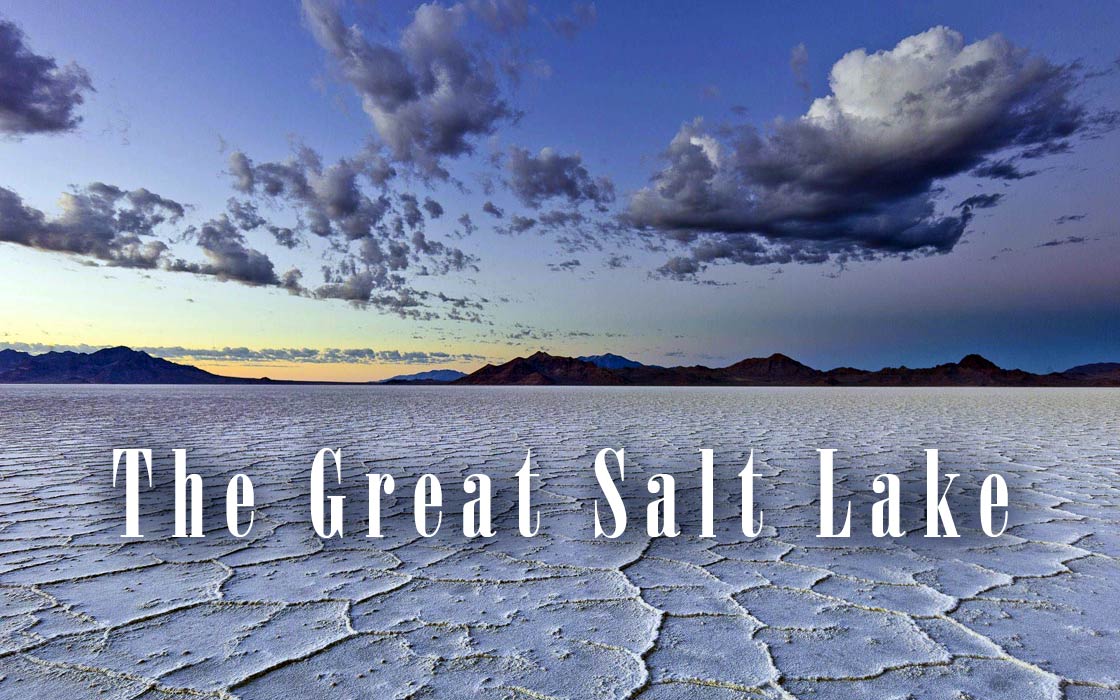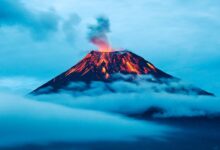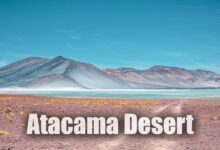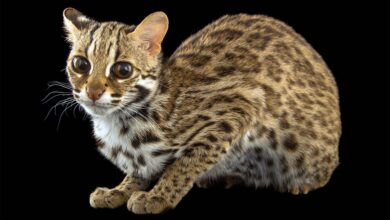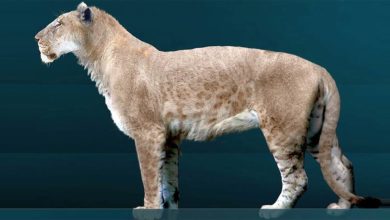The Great Salt Lake: A Natural Wonder with a Rich History
The Great Salt Lake is a remarkable natural wonder that captures the imagination of those who witness its stunning beauty. It covers an area of about 1,700 square miles (4,400 sq km) and has a maximum depth of about 34 feet (10.4 meters). As the largest saltwater lake in the Western Hemisphere, it boasts a unique ecosystem that is home to a diverse array of flora and fauna. From the towering peaks of the Wasatch Mountains to the shimmering salt flats that stretch to the horizon, the Great Salt Lake is a place of incredible contrasts and otherworldly beauty.
The lake’s high salinity levels have led to the formation of remarkable mineral deposits and unique geological formations, such as the famed Spiral Jetty. The lake’s shores are also home to a rich cultural history, with evidence of human habitation dating back thousands of years. Today, the Great Salt Lake remains an important site for research, recreation, and conservation, attracting visitors from around the world who are drawn to its stunning landscapes and fascinating history.
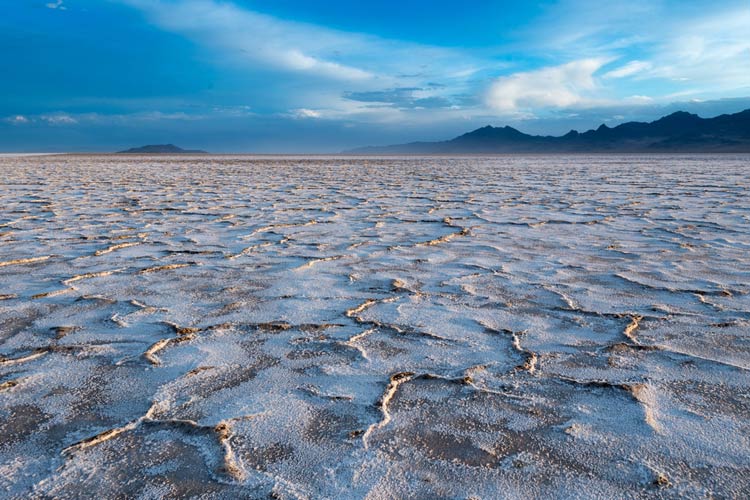
Exploring the Mysteries of the Great Salt Lake
Whether you’re a nature lover, an adventure seeker, or a history buff, the Great Salt Lake offers something for everyone. From exploring Antelope Island State Park to marveling at the flocks of migratory birds that call the wetlands home, there’s no shortage of experiences to be had in this stunning destination. So come discover the wonders of the Great Salt Lake and see for yourself why this incredible natural treasure continues to captivate and inspire.
The lake is saltier than the ocean and its high salt concentration supports a unique ecosystem of brine shrimp and other organisms. The lake has no outlet, with the Salt River being its only significant source of inflow, and evaporation being the primary source of outflow, causing the high salt concentration. The lake is also a major stopover point for millions of migratory birds, making it an important habitat for many species.
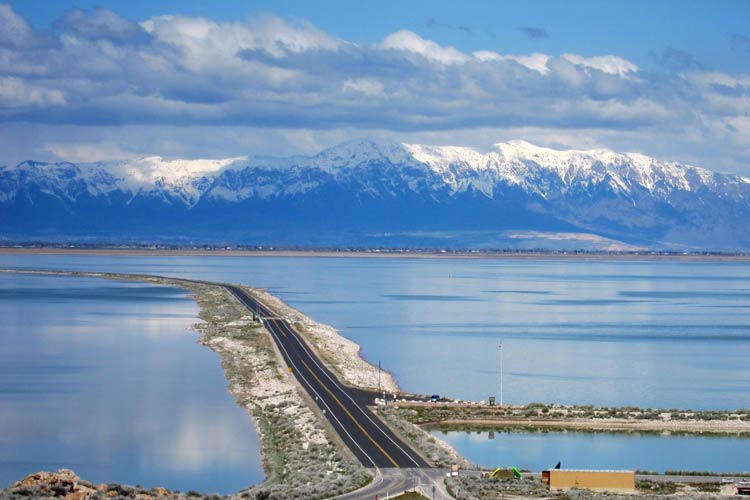
Location
The Great Salt Lake is located in the northern part of Utah, in the United States
Basic Facts About the Great Salt Lake
- Area: approximately 1,700 square miles (4,400 sq km)
- Maximum depth: approximately 34 feet (10.4 meters)
- Length: approximately 75 miles (121 km)
- Width: approximately 28 miles (45 km)
- Salinity: 7 to 27 times saltier than the ocean
- Location: northern Utah, United States.
Origin of the Great Salt Lake
The Great Salt Lake is a remnant of a much larger prehistoric lake known as Lake Bonneville. About 14,000 years ago, Lake Bonneville covered a much larger area of western Utah and parts of Nevada and Idaho. The lake was formed by melting glaciers and was fed by rivers and streams. Over time, the climate changed and the lake began to shrink and eventually became the Great Salt Lake we see today. The lake’s high salt content is a result of its limited outflow, with the Salt River being its only significant source of fresh water inflow, and the high evaporation rate causing the concentration of salt and other minerals in the lake to increase over time.
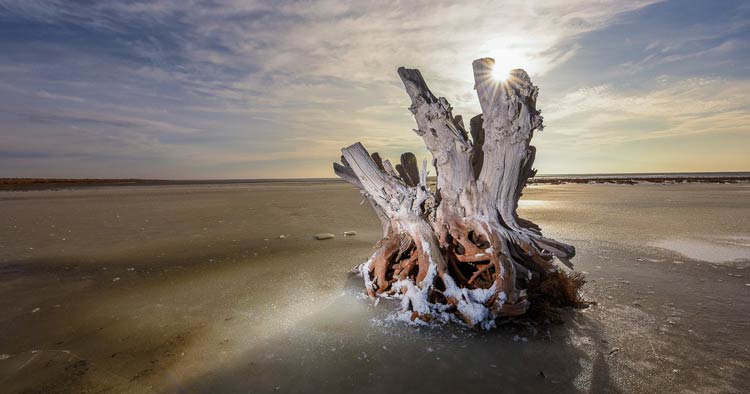
History of discoveries and name of the Great Salt Lake
The Great Salt Lake was discovered and named by American explorer Jim Bridger in 1824. Bridger was a fur trader and mountain man who explored the western United States and was among the first non-Indigenous people to see the lake. The lake was named by Bridger due to its high salt content, which made it inedible for humans and animals.
In 1843, the first group of Mormon pioneers arrived in the area and established Salt Lake City, which is now the capital of Utah. The pioneers initially had trouble finding a reliable source of fresh water, but they eventually realized that the Great Salt Lake could be used as a source of salt, which was in high demand in the area. This discovery led to the establishment of a salt industry in the area, which continued to grow and thrive over the following decades.
Today, the Great Salt Lake is a major tourist attraction and an important source of minerals, including salt and magnesium, for the surrounding region.
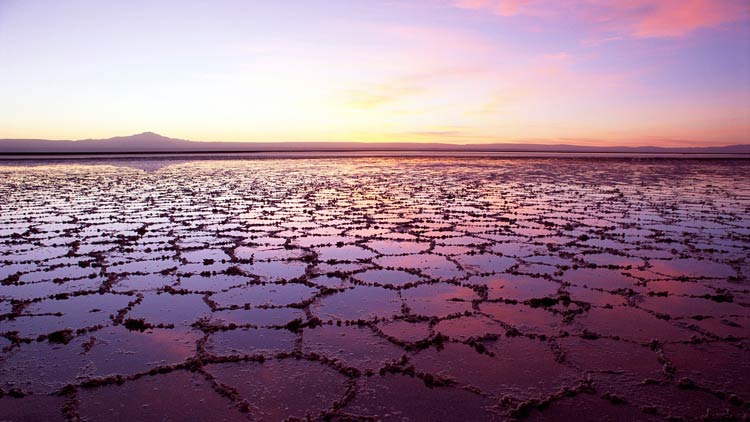
Geography of the Great Salt Lake
The Great Basin is a region that covers most of Nevada and parts of Utah, California, and Idaho. The lake is situated in a shallow, desert basin and is surrounded by mountains, including the Wasatch Range to the east and the Oquirrh Range to the west.
The lake has no outlet and is fed primarily by the Salt River, with additional water inflow from several smaller streams and rivers. The high evaporation rate in the arid climate of the region causes the lake’s water to be highly saline, with salinity levels ranging from 7 to 27 times saltier than the ocean.
The Great Salt Lake is an important stopover point for millions of migratory birds, and supports a unique ecosystem of brine shrimp and other organisms that are adapted to the lake’s high salt levels. The lake is also a major source of minerals, including salt and magnesium, for the surrounding region, and is used for commercial, industrial, and recreational purposes.
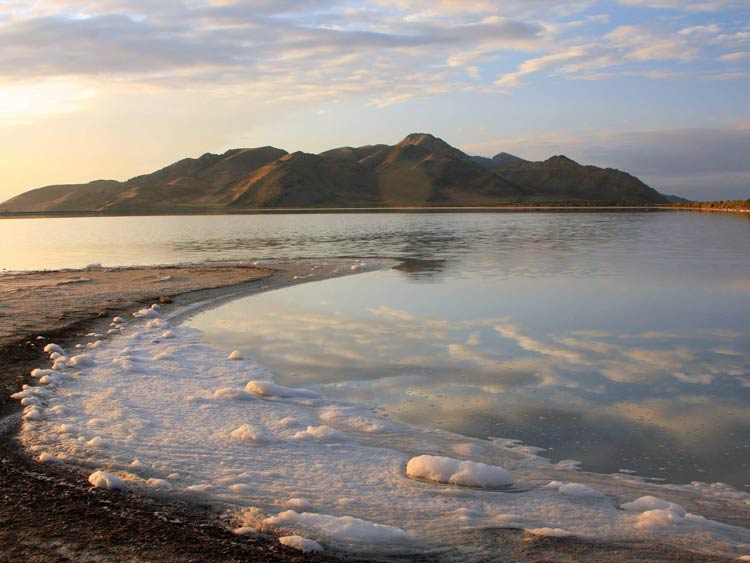
Islands in the Great Salt Lake
The Great Salt Lake has several islands, including:
- Antelope Island
the largest island in the lake, located near the causeway that connects the island to the mainland. Antelope Island is a state park and is known for its scenic beauty, recreational opportunities, and as a habitat for bison, pronghorns, and other wildlife. - Stansbury Island
located near the southern end of the lake, Stansbury Island is the second largest island in the lake. The island is mostly undeveloped, and is known for its scenic beauty and unique geology. - Fremont Island
located in the middle of the lake, Fremont Island is a small, rocky island that is part of the Great Salt Lake State Park. The island is a popular spot for kayaking and other water sports, and is also known for its scenic beauty and wildlife. - Gunnison Island
located near the northern end of the lake, Gunnison Island is a small, rocky island that is a nesting site for several species of birds, including pelicans, gulls, and terns.
These are just a few of the many islands in the Great Salt Lake, each with its own unique characteristics and attractions.
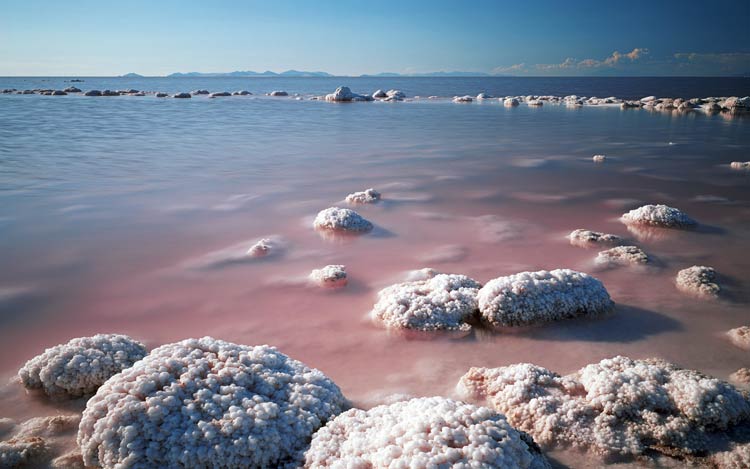
Features of the Great Salt Lake
The Great Salt Lake has several notable features, including:
- High salinity
The lake is saltier than the ocean, with salinity levels ranging from 7 to 27 times saltier than the ocean, making it one of the saltiest bodies of water in the world. - Unique ecosystem
The high salt levels of the lake support a unique ecosystem of brine shrimp and other organisms that are adapted to the lake’s conditions. The lake is also an important stopover point for millions of migratory birds, making it an important habitat for many species. - Scenic beauty
The lake is surrounded by mountains and desert landscapes, making it a popular spot for tourists and photographers. The lake’s bright blue color and otherworldly appearance make it a unique and visually striking location. - Mineral resources
The lake is a major source of minerals, including salt and magnesium, for the surrounding region, and is used for commercial, industrial, and recreational purposes. - Recreational opportunities
The lake offers a variety of recreational opportunities, including boating, fishing, kayaking, and birdwatching. Antelope Island, Stansbury Island, and Fremont Island are popular spots for these activities, and are also known for their scenic beauty and wildlife. - Historical significance
The lake has a rich history, including its discovery by American explorer Jim Bridger in 1824, and its role as a resource for the Mormon pioneers who established Salt Lake City in the 1840s. The lake is also an important cultural and spiritual resource for many Indigenous peoples in the region.
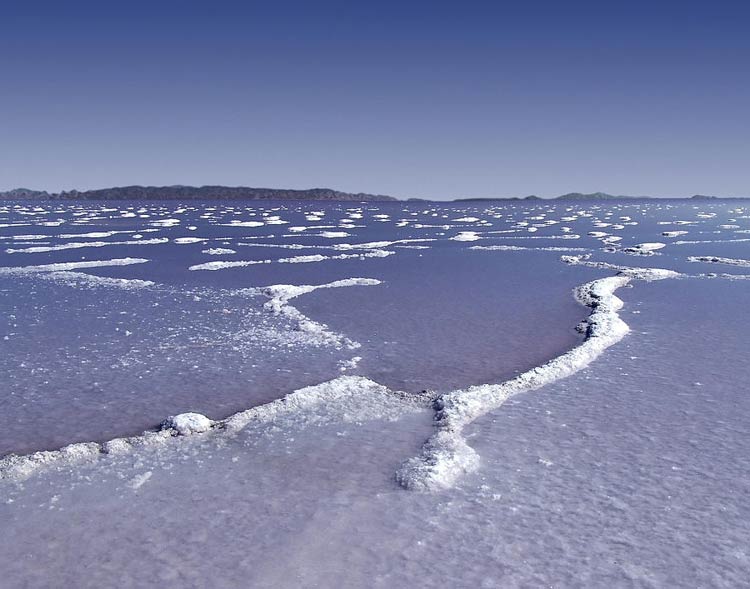
Geology of the Great Salt Lake
The Great Salt Lake is located in the northern part of Utah, USA. It is the largest saltwater lake in the Western Hemisphere and one of the saltiest bodies of water in the world. The lake was formed by the blocking of the Jordan River by sediment deposits, which caused the water to become stagnant and evaporate, leaving behind high levels of salt and minerals.
The lake bed is composed of sedimentary rock formations, including shale, sandstone, and limestone. The surrounding area is part of the Basin and Range geological province, characterized by mountain ranges and basins created by tectonic activity. The lake is fed by several rivers and streams, including the Bear River, and its level can vary greatly due to fluctuations in precipitation and water usage.
Climate of the Great Salt Lake
The climate of the Great Salt Lake area is classified as a semi-arid or steppe climate, characterized by hot summers and cold winters. The average temperature in the summer (July) is around 25°C (77°F), while in the winter (January) it is about 0°C (32°F).
The temperature of the lake itself is influenced by the surrounding air temperature and can range from 4°C (39°F) in the winter to 27°C (81°F) in the summer. It is important to note that the high salt content of the lake can affect the perceived air temperature, as the air above the lake can feel much warmer or cooler than the air a few miles away.
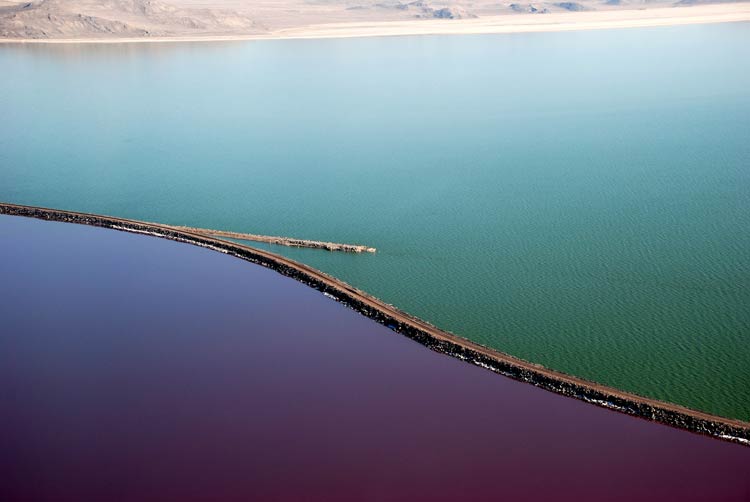
The Great Salt Lake effect
The Great Salt Lake effect refers to the influence the lake has on the local weather and climate in the surrounding area. This effect is due to the large size and high salt content of the lake, which can cause differences in temperature, humidity, and wind patterns compared to the surrounding land. For example, the lake can cause increased evaporation, leading to higher humidity levels and the formation of fog, particularly in the summer months.
The lake can also cause local temperature differences, as the warm water can heat the air above it and create localized pockets of warm air. Additionally, the shape of the lake and the surrounding mountains can cause wind patterns that can influence the weather in the surrounding area. Overall, the Great Salt Lake effect is small but can still be noticeable and can play a role in the local microclimate.
Mineral deposits
The Great Salt Lake is known for its high mineral content, particularly sodium chloride (table salt) and potassium chloride. Other minerals found in the lake include magnesium, calcium, and sulfate.
The lake’s high salt content is due to its unique hydrology – it has no outlet, so water flows in from rivers and streams, but cannot flow out. As water evaporates from the lake’s surface, minerals become more concentrated, leading to the formation of mineral deposits.
These mineral deposits are commercially valuable and are mined from the lake’s shores and from evaporation ponds. The mining of these minerals has been an important industry in the Great Salt Lake region for more than 100 years. However, mining and other human activities can also have negative impacts on the lake’s ecosystem and water quality, and balancing economic development with environmental protection is an ongoing challenge.

Flora in the Great Salt Lake
The flora around the Great Salt Lake in Utah is dominated by salt-tolerant species that are adapted to the harsh, semi-arid climate and the high salt content of the soil and water. Some of the common plant species in the area include:
- Saltgrass (Distichlis spicata)
- Greasewood (Sarcobatus vermiculatus)
- Russian thistle (Salsola tragus)
- Glasswort (Salicornia sp.)
- Pickleweed (Salicornia virginica)
Additionally, several species of wetland and shoreline plants can be found in the marshes and shallow waters along the edges of the lake, including:
- Cattails (Typha sp.)
- Bulrushes (Scirpus sp.)
- Wildflowers (such as Mentzelia sp., Phlox sp., and Eriogonum sp.)
These plants provide important habitats for wildlife, including birds, insects, and small mammals, and play a role in the local ecosystem by stabilizing the shoreline and filtering pollutants from the water.
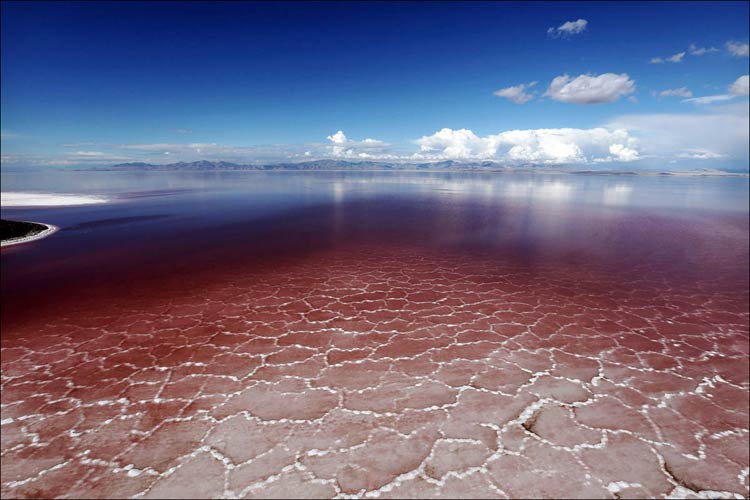
Fauna in the Great Salt Lake
The Great Salt Lake and its surrounding area support a diverse array of wildlife, including both aquatic and terrestrial species. Some of the notable fauna in the area include:
- Brine shrimp (Artemia franciscana)
- Birds
- American white pelican (Pelecanus erythrorhynchos)
- California gull (Larus californicus)
- Snowy plover (Charadrius nivosus)
- Eared grebe (Podiceps nigricollis)
- Sandhill crane (Antigone canadensis)
- Invertebrates
- Saltwater clams (Macoma balthica)
- Fairy shrimp (Branchinecta sp.)
- Mammals
- Pronghorn (Antilocapra americana)
- Bighorn sheep (Ovis canadensis)
- Coyote (Canis latrans)
- Muskrat (Ondatra zibethicus)
These animals play important roles in the Great Salt Lake ecosystem, serving as food for predators, helping to maintain the balance of the food web, and contributing to the overall health and diversity of the ecosystem. Additionally, several species of fish, reptiles, and amphibians can be found in the lake or in the surrounding streams and rivers.
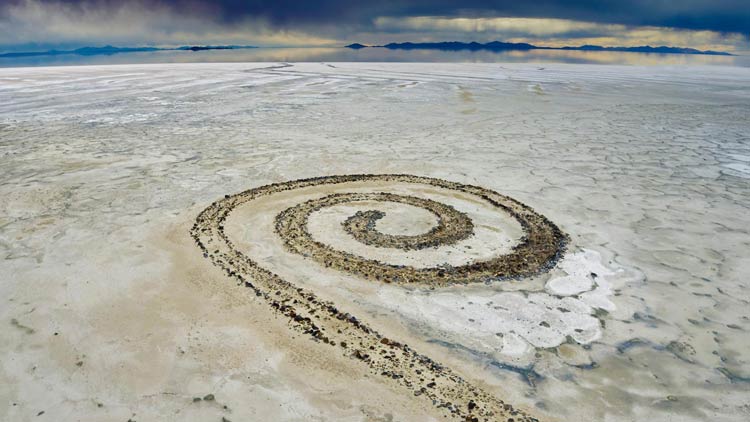
Tourism and tourist main attractions in the park
The Great Salt Lake and its surrounding area offer a range of recreational opportunities and attractions for tourists. Some of the main tourist attractions in the area include:
- Antelope Island State Park
A 42-square-mile island in the middle of the lake offers scenic views, hiking and biking trails, wildlife viewing opportunities, and a historic ranch. - The Great Salt Lake Marina
A recreational marina that offers boating, fishing, and other water-based activities on the lake. - The Great Salt Lake Shorelands Preserve
A protected area that provides access to the lake’s unique shoreline and offers hiking, bird watching, and other outdoor recreational opportunities. - The International Peace Garden
A beautiful garden located on the lake’s southern shore features sculptures, gardens, and a peaceful setting. - The Bonneville Salt Flats
a vast, flat expanse of salt that covers over 30,000 acres and is a popular destination for speed enthusiasts and photographers. - The Saltair Resort
A historic lakefront resort that was once a popular destination for tourists in the early 20th century.
These attractions and others provide visitors with opportunities to enjoy the natural beauty and unique characteristics of the Great Salt Lake and its surrounding area. The lake and its surroundings also offer many recreational opportunities, including boating, fishing, hiking, camping, and wildlife viewing.
How To Reach To the Great Salt Lake?
The Great Salt Lake can be reached by car or public transportation. Here are some options:
- By car
The lake is located about 16 miles (26 km) west of Salt Lake City, Utah. Visitors can reach the lake by taking I-80 westbound and exiting at either Exit 104 (Saltair Drive) or Exit 112 (Antelope Drive). From there, visitors can access various points along the lake’s shore, as well as Antelope Island State Park. - By public transportation
The Utah Transit Authority (UTA) operates a bus route that provides service to Antelope Island State Park. Visitors can take the bus from downtown Salt Lake City or from the Davis County area. UTA also operates a light rail system (TRAX) that provides service to the Salt Lake City area, making it possible to access the lake via public transportation. - By air
The closest airport to the Great Salt Lake is Salt Lake City International Airport, which is located about 15 miles (24 km) east of the lake. From the airport, visitors can rent a car or take public transportation to access the lake.
Once at the lake, visitors can explore various points of interest, including state parks, islands, and recreational areas.
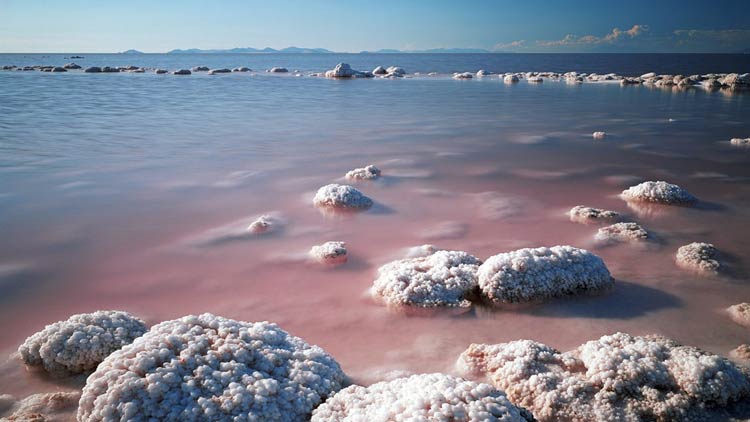
Best Time To Visit the Great Salt Lake
The best time to visit the Great Salt Lake depends on what you want to do and see. Here are some things to keep in mind:
- Summer (June to August)
Summer is the most popular time to visit the Great Salt Lake, as the weather is warm and sunny. This is a great time for swimming, boating, and other water sports, as well as hiking and exploring the lake’s islands and shorelines. - Spring (March to May) and Fall (September to November)
These seasons offer cooler temperatures and fewer crowds than summer, making them a good time to visit if you want to avoid the heat and crowds. Spring is also a good time for birdwatching, as many migratory birds pass through the area. - Winter (December to February)
Winter is the least popular time to visit the Great Salt Lake, as temperatures can be very cold and many facilities and attractions may be closed. However, winter can be a good time for birdwatching and photography, as well as cross-country skiing and other winter sports.
The best time to visit the Great Salt Lake depends on your interests and preferences. Regardless of when you visit, be sure to check the weather and road conditions before you go, and be prepared for the lake’s unique environment and conditions.
Places to visit
The Great Salt Lake has many interesting places to visit, including:
- Antelope Island State Park
This park is located on the largest island in the Great Salt Lake and offers hiking trails, wildlife viewing, camping, and a beach for swimming and sunbathing. - Great Salt Lake Shorelands Preserve
This nature preserve offers birdwatching opportunities and educational exhibits about the lake’s ecosystem. - Saltair
This historic resort on the shores of the Great Salt Lake was originally built in the late 19th century and has since been rebuilt and restored. It now offers a museum, gift shop, and event space. - Spiral Jetty
This land art installation by artist Robert Smithson is located on the north shore of the Great Salt Lake and consists of a 1,500-foot-long (457-meter) coil of rocks that juts out into the water. - Bear River Migratory Bird Refuge
This wildlife refuge is located near the northern end of the lake and offers excellent birdwatching opportunities, as well as hiking trails and educational exhibits. - Golden Spike National Historical Park
This park is located about 35 miles (56 km) north of the lake and commemorates the completion of the transcontinental railroad in 1869. It features exhibits, a visitor center, and a replica of the golden spike that was used to mark the completion of the railroad.
These are just a few of the many places to visit in and around the Great Salt Lake.
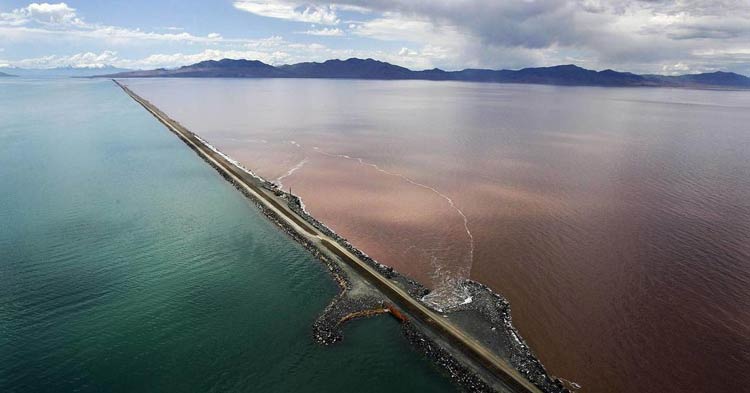
Conservation
Conservation efforts are important for the Great Salt Lake due to its ecological and economic importance. Here are some examples of conservation efforts in the Great Salt Lake:
- Protection of wetlands
The wetlands around the Great Salt Lake are important habitats for migratory birds and other wildlife, and many organizations work to protect these areas from development and other threats. - Monitoring water quality
The Great Salt Lake is susceptible to pollution from urban runoff, agricultural runoff, and other sources. Water quality monitoring and conservation efforts aim to protect the lake’s ecosystem and ensure its continued use for industry and recreation. - Restoration of habitats
Some areas of the Great Salt Lake have been degraded by past human activities, such as the construction of causeways that disrupted natural water flows. Restoration efforts aim to restore these areas to their natural state and improve their ecological value. - Education and outreach
Education and outreach efforts aim to increase public awareness of the importance of the Great Salt Lake and the need for conservation. These efforts include exhibits, educational programs, and community events.
These and other conservation efforts help to protect the Great Salt Lake and ensure its continued ecological and economic value.
Great Salt Lake in numbers
The Great Salt Lake is the largest saltwater lake in the Western Hemisphere, and one of the saltiest bodies of water in the world. Here are some key dimensions and statistics about the lake:
- Surface area: approximately 4,400 square kilometers (1,700 square miles)
- Length: approximately 141 kilometers (87 miles)
- Maximum width: approximately 77 kilometers (48 miles)
- Average depth: approximately 12 meters (40 feet)
- Maximum depth: approximately 34 meters (112 feet)
- Volume: approximately 12,000 cubic kilometers (2,900 cubic miles)
- Salt concentration: approximately 27% (6-8 times saltier than the ocean)
These dimensions and statistics demonstrate the impressive size and unique characteristics of the Great Salt Lake, making it an important and distinctive feature of the Utah landscape.
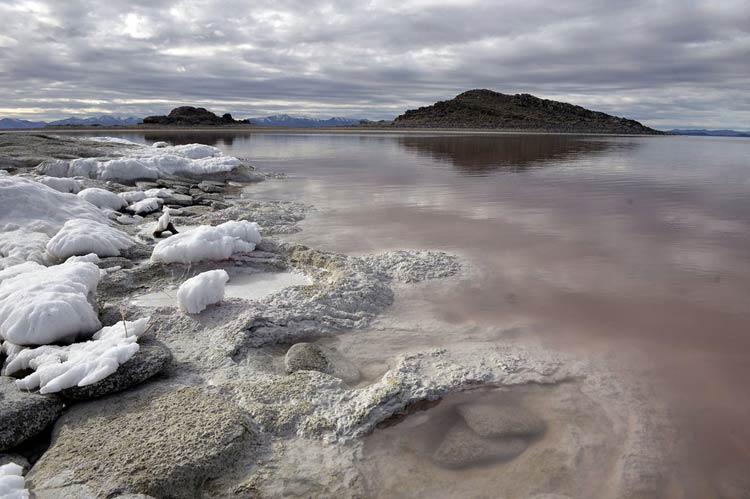
Legends and unusual features of the Great Salt Lake
According to local legend, the Great Salt Lake was created by a powerful earthquake that caused the land to sink and form a basin. This earthquake is said to have been caused by the gods to punish humans for their misdeeds.
The “Island of the Gods” is a legend associated with the Great Salt Lake that says that a group of gods once lived on an island in the lake and controlled the weather and the water levels. According to the legend, the gods disappeared one day, leaving the island and the lake behind.
Interesting facts about the Great Salt Lake
The Great Salt Lake is a unique and fascinating body of water that is rich in history, geology, and ecology. Here are a few interesting facts about the lake:
- The Great Salt Lake is the largest saltwater lake in the Western Hemisphere and one of the saltiest bodies of water in the world.
- The lake is fed by several rivers and streams, but has no outlet. This means that the salt and minerals in the lake are highly concentrated, making it extremely salty.
- The salt content of the lake is so high that it is almost impossible for most fish and other aquatic life to survive in the water. However, the lake is home to brine shrimp, which are an important food source for migratory birds.
- The Great Salt Lake has been used for various purposes throughout history, including salt mining, mineral extraction, recreation, and tourism.
- The lake has a unique and dynamic shoreline that changes constantly as the water level fluctuates, exposing vast areas of salt flats and creating new islands and beaches.
- The lake is surrounded by a diverse landscape, including deserts, mountains, wetlands, and forests, making it a popular destination for outdoor recreation, wildlife viewing, and photography.
These are just a few of the many interesting and unique characteristics of the Great Salt Lake, making it an important and fascinating feature of the Utah landscape.
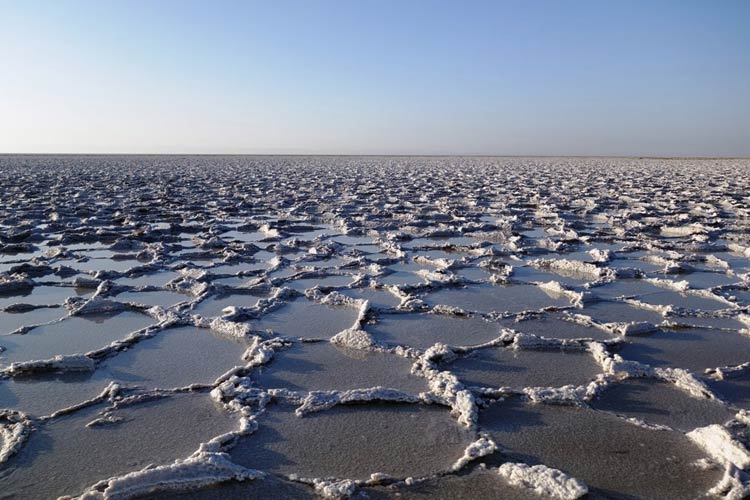
Q&A (questions and answers) about the Great Salt Lake
Q: What is the Great Salt Lake?
A: The Great Salt Lake is the largest saltwater lake in the Western Hemisphere, located in the northern part of Utah in the United States.
Q: What is the “Sailing Stones” phenomenon?
A: The “Sailing Stones” phenomenon is an unusual feature of the Great Salt Lake that refers to large rocks that seem to move on their own across the surface of the lake’s playa, or flat surface. This movement is thought to be caused by strong winds and ice, but the exact mechanism is not well understood.
Q: Are there any other unusual features of the Great Salt Lake?
A: Another unusual feature of the Great Salt Lake is its high salt concentration, which creates unique salt formations and provides a habitat for brine shrimp and algae. The lake is also known for its scenic beauty and its diverse landscape, which includes deserts, mountains, wetlands, and forests.
Q: What is the size of the Great Salt Lake?
A: The Great Salt Lake covers an area of approximately 4,400 square kilometers (1,700 square miles).
Q: What is the average depth of the Great Salt Lake?
A: The average depth of the Great Salt Lake is approximately 12 meters (40 feet).
Q: What is the salt concentration of the Great Salt Lake?
A: The salt concentration of the Great Salt Lake is approximately 27%, making it one of the saltiest bodies of water in the world.
Q: What is the main source of water for the Great Salt Lake?
A: The Great Salt Lake is fed by several rivers and streams, including the Jordan River, Bear River, and Weber River.
Q: What is the significance of the Great Salt Lake?
A: The Great Salt Lake is significant because it is the largest saltwater lake in the Western Hemisphere and one of the saltiest bodies of water in the world. It also provides important habitat for wildlife, such as migratory birds, and is a popular destination for outdoor recreation and tourism.
Q: What is the main attraction of the Great Salt Lake?
A: The main attractions of the Great Salt Lake include its scenic beauty, its unique salt formations, and its diverse wildlife. The lake is surrounded by a diverse landscape, including deserts, mountains, wetlands, and forests, making it a popular destination for outdoor recreation, wildlife viewing, and photography.
Q: What kind of recreational activities can be done at the Great Salt Lake?
A: The Great Salt Lake and its surrounding area offer a wide range of recreational activities, including boating, fishing, hiking, camping, and wildlife viewing. The lake is also a popular destination for bird watching, photography, and speed events on the Bonneville Salt Flats.
Q: What is the history of the Great Salt Lake?
A: The Great Salt Lake has a rich history that dates back thousands of years, with indigenous peoples using the lake for food, medicine, and trade. European settlers also discovered the lake in the 19th century and began using it for salt mining, mineral extraction, and transportation. Today, the lake is a popular destination for outdoor recreation and tourism.
Q: How does the Great Salt Lake benefit the environment?
A: The Great Salt Lake provides important habitat for a variety of wildlife, including migratory birds, brine shrimp, and algae. The lake also acts as a natural filter for pollutants and helps recharge groundwater in the surrounding area.
Q: Why is the Great Salt Lake so salty?
A: The Great Salt Lake is so salty because it has no outlet, meaning that the salt and minerals in the water are not flushed out and instead become highly concentrated. Additionally, the lake receives high amounts of salt from the many rivers and streams that feed into it.
Q: How does the water level of the Great Salt Lake fluctuate?
A: The water level of the Great Salt Lake fluctuates due to changes in precipitation and evaporation rates. When there is more precipitation and less evaporation, the water level rises, and when there is less precipitation and more evaporation, the water level decreases.
Q: What are the main industries associated with the Great Salt Lake?
A: The main industries associated with the Great Salt Lake include salt mining, mineral extraction, tourism, and outdoor recreation. The lake is also an important resource for irrigation, water treatment, and industrial processes.
Q: Can you swim in the Great Salt Lake?
A: Yes, you can swim in the Great Salt Lake, but the high salt concentration can make it difficult to float and can irritate skin and eyes. It is also recommended to avoid swallowing the water or getting it in your mouth.


